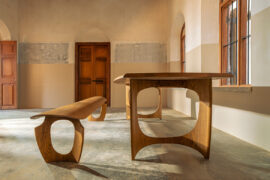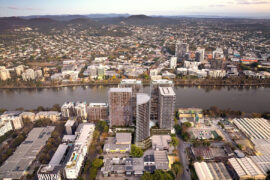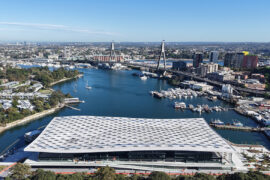As a UNESCO Creative City of Craft and Folk Art, Ballarat is hosting Craft Lab and The Great Takeaway this month. Nicole Durling, Executive Director at Craft Victoria, tells us more.

Craft Lab 2023, photo by Tony Evans.
May 15th, 2025
Nicole Durling is Executive Director at Creative Victoria, having spent more than 20 years in the creative sector as an artist, curator, board director, advocate, advisor and executive leader. Her experience includes working in public, private, commercial and not-for-profit organisations and businesses. After 15 years as Director of Collections and Exhibitions with the Museum of Old and New Art (Mona) in Hobart, Nicole commenced her role as Executive Director of Craft Victoria in mid-2021. With Craft Lab 25 kicking off on May 17th, Nicole comments here on the power and value of community craft traditions in design.

In an era increasingly defined by digital experiences and mass production, we’re witnessing a remarkable resurgence in the appreciation for handmade objects. This revival isn’t simply nostalgia – it represents a profound shift in how we understand value in our cultural lives.
Every day, I observe how craft practices create connections, preserve heritage and strengthen communities. The power of craft lies in its dual nature – simultaneously honouring tradition while evolving to reflect contemporary concerns.
Craft as living heritage
What we call ‘craft’ today represents centuries of accumulated knowledge, passed through generations and continuously adapted. Yet, unlike preserved artefacts in museums, craft traditions thrive by evolving. Today’s practitioners reimagine traditional techniques and materials to address contemporary concerns and aesthetics while maintaining connections to cultural legacies.
This creates a form of cultural resilience. When communities maintain craft traditions, they preserve not just techniques but entire knowledge and cultural systems about materials, sustainability and problem-solving approaches that are enduring and relevant in our modern world.

Connection in an age of isolation
One of the most significant values of craft lies in its ability to foster authentic human connection. When audiences engage directly with artisans, objects transform from commodities into carriers of stories. Professor Susan Luckman, Professor of Culture and Creative Industries at the University of South Australia and a leading expert on creative industries and craft economies in Australia, notes in her research: “The storytelling piece is really huge. The connection between audience and the artisan holds tremendous value.”
These stories travel with the objects into our homes and our daily lives, creating ongoing relationships to the places and people who created them. In a time when many feel increasingly disconnected from how things are made and where they come from, craft provides tangible connections to human creativity and place.

Supporting sustainable creative communities
Successful communities that value craft, develop resilient networks where knowledge is shared, collaborations form and practitioners find peer support essential for navigating the challenges of creative entrepreneurship.
These networks require thoughtful support, from guidance on pricing strategies and marketing to exhibition opportunities and grant applications – but there’s a careful balance to strike. As Professor Luckman’s research finds, craftspeople aren’t opposed to financial success, but resist models that would separate them from their practice. “They’re not hostile to making more money,” Luckman explains. “They’re hostile to no longer being a maker. They don’t want to be a business owner. They want to be a maker who runs a business in that space.”
Beyond economic metrics
While the economic impact of craft sectors is significant in many regions, focusing solely on these metrics misses the deeper significance of craft in communities. In conversations with practitioners, I’m struck by how rarely they measure success in purely financial terms. Instead, they speak of building knowledge, learning techniques, creating objects that will outlive them and the meaning derived from connecting with communities through their work.
This perspective challenges conventional development paradigms. Success should be measured not just in dollars generated but in relationships fostered, skills developed and community identity strengthened.
Related: Interview with Tosin Oshinowo

One program exemplifying these principles is the UNESCO Creative City of Ballarat’s Craft Lab, presented in partnership between the City of Ballarat, Craft Victoria, and the Centre for Rare Arts and Forgotten Trades. Ballarat’s craft scene is particularly distinctive for its significant connection to clay due to its rich history of gold mining and the subsequent development of a vibrant creative scene, including ceramics. The city boasts a variety of clay deposits and has long been known for its artisanal pottery and clay-based crafts. This connection to place gives Ballarat’s craft community a unique character among Victorian creative regions.
At its core, Craft Lab identifies talented practitioners and provides them with professional development to build sustainable careers while showcasing their work to broader audiences. Craft Victoria leads this development component, working directly with 18 selected makers to refine their creative practice, strengthen their business skills, and connect them with markets, opportunities and networks.
The program culminates in a public exhibition at the historic Mining Exchange over two weekends in May (17-18th and 24-25th), where practitioners demonstrate their skills across diverse disciplines including textiles, ceramics, furniture-making and millinery.
A highlight of the program is The Great Takeaway on 22nd May – an innovative dining event merging craft and cuisine. This experience connects artisans directly with 60 guests who enjoy a three-course meal using handcrafted tableware, which they then take home as their complete dining set.

The program also includes the Deep Listening Project, led by Wadawurrung artist Jenna Oldaker, which exemplifies craft’s role in preserving living heritage. Six immersive installations will reflect First Nations voices and experiences, demonstrating how craft traditions can bridge cultural understanding and strengthen connection to place — a powerful example of how craft practices sustain community identity.
The Craft Lab program demonstrates how cultural development and economic growth can meaningfully coexist. Ballarat’s creative sector has contributed $658.4 million to the local economy, with cultural tourism growing 25 per cent year-on-year since the city received its UNESCO Creative City designation in 2019.
What makes initiatives like Craft Lab truly valuable is how they foster authentic connection in an increasingly homogenised marketplace. By investing in local creative talent and providing platforms for practitioners to reach audiences, regions develop distinctive cultural identities that benefit both visitors and residents.
The practitioners we work with consistently emphasise that their measure of success extends far beyond financial metrics. Their true value lies in preserving and evolving craft traditions, creating objects with lasting significance and strengthening community bonds through shared creative experiences. As our digital world continues to expand, the tangible, material connections that craft provides become increasingly precious. The renaissance of craft in regional centres like Ballarat reminds us that cultural identity isn’t manufactured — it’s carefully cultivated through the relationships between makers, materials and the communities they serve.
Craft Victoria
craft.org.au
Photography
Tony Evans, Josh Waddell

INDESIGN is on instagram
Follow @indesignlive
A searchable and comprehensive guide for specifying leading products and their suppliers
Keep up to date with the latest and greatest from our industry BFF's!

Rising above the new Sydney Metro Gadigal Station on Pitt Street, Investa’s Parkline Place is redefining the office property aesthetic.

The undeniable thread connecting Herman Miller and Knoll’s design legacies across the decades now finds its profound physical embodiment at MillerKnoll’s new Design Yard Archives.

For Aidan Mawhinney, the secret ingredient to Living Edge’s success “comes down to people, product and place.” As the brand celebrates a significant 25-year milestone, it’s that commitment to authentic, sustainable design – and the people behind it all – that continues to anchor its legacy.

Architect, designer and craftsman Adam Markowitz bridges the worlds of architecture and fine furniture, blending precision, generosity and advocacy to strengthen Australia’s craft and design community.

Inside Bangkok’s Siam Paragon Mall, L’Atelier by Dinding Design Office celebrates the artistry of independent watchmaking through a space defined by light, craft and meticulous detail.
The internet never sleeps! Here's the stuff you might have missed

Plus Studio and ICD Property have submitted a proposal for a development on Brisbane’s Donkin Street, using a 1.68-hectare former industrial site as a new riverside residential and community destination.

With a date now set for January 2026, Sydney’s landmark project is taking shape as a significant and welcome addition to civic life in the city.